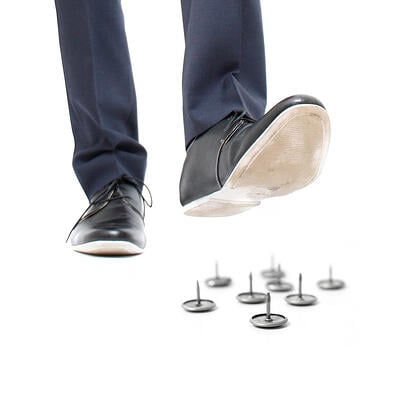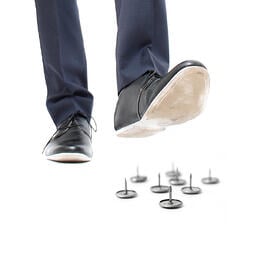CEO Blog - Advice for CEOs on growth and scaling
Making our Mistakes Pay – Rather than Paying for our Mistakes

 No one likes making mistakes, but we all make our fair share of them. Humans are fallible, products and processes fail, and things slip through the cracks. Even the best-managed companies can go awry. Unfortunately, mistakes are not only inevitable; they can also be very costly. As a CEO you know that mistakes can cause operations costs to rise and productivity to falter—and most damaging of all, they frustrate our customers so that they start thinking about taking their business elsewhere. If we act quickly to fix our mistakes, however, we can make our mistake pay off.
No one likes making mistakes, but we all make our fair share of them. Humans are fallible, products and processes fail, and things slip through the cracks. Even the best-managed companies can go awry. Unfortunately, mistakes are not only inevitable; they can also be very costly. As a CEO you know that mistakes can cause operations costs to rise and productivity to falter—and most damaging of all, they frustrate our customers so that they start thinking about taking their business elsewhere. If we act quickly to fix our mistakes, however, we can make our mistake pay off.
Losing and replacing customers is expensive. 91% of unhappy customers will not willingly do business with us again (Source: U.S. Office of Consumer Affairs). If they have the option, they will take their business elsewhere. When customers leave us, we need to expend resources getting new ones—and it generally costs a great deal more to get a new customer than to keep an existing one. Think of the difference in the time, effort and money that goes into marketing and sales to bring in new business compared with how little effort it takes to stay connected with a customer you already have. Losing and replacing customers is expensive.
News travels fast, and bad news travels faster and farther than good news. As you have read in other Chief Outsiders recent blogs, with today’s social media popularity, news of our mistakes can reach more than twice as many people as news of a good customer experience. On average, a satisfied customer tells three or four people about a positive experience while an unhappy customer tells nine to 15 people about one of our mistakes—and 13% of unhappy customers tell more than 20 people (Source: U.S. Office of Consumer Affairs). It can take 12 positive experiences to make up for just one negative customer experience (Source: “Understanding Customers”, Ruby Newell-Legner). In the digital age when people are always connected, however, all bets are off. People today are always connected and constantly sharing their experiences through texts, posts, tweets, and yelps. There is simply no predicting how many people a single negative online review will reach—but there are two things we can be sure of: (1) people are always sharing their impressions, and (2) people are more likely to vent about a negative experience than to praise us for a good experience.
The key to turning around a mistake: fix the mistake to the customer’s satisfaction as quickly as possible. While 91% of unhappy customers will leave us if they have a choice, when we resolve complaints in the customer’s favor 70% of those who have had a negative experience will do business with us again. That number goes up to 96% when the customer feels that we acted quickly. Furthermore, those who feel we resolved in their favor quickly are actually likely to recommend us to others, to become our promoters who spread positive word-of-mouth (Source: U.S. Office of Consumer Affairs). Well-performed recovery from mistakes builds customer loyalty and increases positive word-of-mouth. So fixing mistakes quickly in the customer’s favor pays dividends of customer retention, customer loyalty and positive word-of-mouth.
Four Steps to Turning around Mistakes
Step One: Encourage Complaints.
Get rid of those signs that say “The deadline for all complaints was yesterday.” We cannot fix a problem unless we know that it has occurred—and we need to know about a problem before we read about it on Yelp, Twitter or Facebook. We need to encourage customers to complain to us before they hit SEND and launch their complaints into cyberspace.
- Go looking for complaints.Don’t assume that just because a customer has not complained that the customer is happy. Less than 4% of unhappy customers complain (Source: U.S. Office of Consumer Affairs). Proactively seek feedback from customers. That not only teaches them that we want to know when something is not right, but it helps build strong relationships—and having a strong relationship with our customers makes them more forgiving when mistakes do occur.
- Make it easy for customers to complain. Eliminate unnecessary barriers between you and your customers. Technology, processes and procedures need to make it at least as easy for customers to complain directly to us as it is for them to post an online review—and get them to a live person as easily and quickly as possible. If they haven’t reached a live person in 2 minutes or less, then you have lost them. Sitting on hold, waiting 24 hours or more for a return phone call or email, being passed on to a second or third person all increase an already-unhappy customer’s frustration level.
Step Two: Remember that the customer is always right.
If a customer says we made a mistake, then we made a mistake. Accept it—and make it right. We cannot win by doing anything else. It is counterproductive to try to convince the customer that we did everything right; that is simply telling customers that they don’t really have a problem. It is just as counterproductive to offer excuses; our customers do not care that a vendor shorted us, that our server was down, or that we are transitioning in a new employee—those are our problems, not theirs. But by far the worst thing we can do in the middle of trying to recover from a problem is explain to customers what they did wrong. Blaming the customer is never a good idea. When a customer complains, we need to do two things and only two things: 1) find out what the customer needs fixed, and 2) figure out how we can fix it. This means that our staff needs to be trained to handle customer complaints effectively using the correct mix of empathy, apology and resolution.
Step Three: Fix it for the customer ASAP.
Put out the fire fast. Our customers have neither the time nor the inclination to wait through a prolonged recovery process. By acting too slowly we risk expensive customer attrition and damaging negative word-of-mouth. The faster we act, the more satisfied the customer. We engender customer loyalty, positive word-of-mouth and customer referrals not just by taking action but by acting fast. Fast action requires that staff be empowered to develop and implement solutions. Problems cannot be fixed quickly if staff must refer problems up the chain of command for resolution.
Step Four: After you have put out the fire, figure out what went wrong – and make changes.
After we have made things right for the customer, we need to learn from what happened and make changes to avoid the same thing happening again. Repeating mistakes undermines the customer loyalty that you build up by well-performed recovery. We want to make sure that the real problem is solved, not just the symptoms, so that we do not keep making the same mistake over and over again. Not to worry: there will be plenty of opportunity for new mistakes that you can capitalize on! It can be a good idea to bring the customer back into the conversation at this point; doing so can provide some additional insight into what went wrong and help strengthen the relationship. Minimally, we should follow up with customers to thank them for bringing the problem to attention so that we could fix it for them and to let them know that they have helped us work out a solution to our problem.
Topics: CEO Perspectives, CEO Strategies, CEO Choices
Sun, Dec 9, 2012Related Articles

- Press Releases
- Careers
- Case Studies
- Marketing Consultant Company
- Marketing Strategy Consultants
- Marketing Plan Consultants
- B2B Marketing Consultants
- Virtual CMO
- Marketing Consultant Outsourcing
- Fractional CMO
- What is a Fractional CMO
- Healthcare Marketing Consultant
- Marketing Consultant Houston TX Texas
- Marketing Consultant Texas TX
- Marketing Consultant Bay Area
- CEO Blog
- Ebooks Plus
- Executive Marketing Consultants
- Product Marketing Consultants
- B2C Marketing Consultants
- Virtual Marketing Consultants
- Senior Marketing Consultants
- Temporary CMO
- Hire a CMO
- Fractional CMO Salary
- Fractional CMO Responsibilities
- Marketing Consultant Austin TX Texas
- Marketing Consultant Dallas TX Texas
- Marketing Consultant San Antonio
- Helping Private Equity
- Private Equity Blog
- Leadership Team
- Privacy Policy
- Business Marketing Consultants
- Strategic Marketing Consultants
- Marketing Technology Consultants
- Sales and Marketing Consultants
- CMO Job Description
- CMO Salary
- Fractional CMO Agency
- Fractional CMO Services
- CPG Marketing Consultant
- Marketing Consultant San Diego
- Partners
Houston, TX 77056
© 2023 Chief Outsiders

